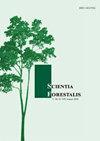Influence of fire on edge vegetation in an Atlantic Forest remnant in Brazil
IF 0.4
4区 农林科学
Q4 FORESTRY
引用次数: 0
Abstract
Fires and habitat fragmentation are responsible for devastating large ecosystems around the biosphere. The increasing use of remote sensing allows fire patterns to be identified and plays an essential role in preventing fires. In this context, this study aimed to describe the variation in evidence of fire between the edge and the interior of an Atlantic Forest remnant in southeastern Brazil and infer its effects on vegetation. Fire records were acquired between 2010 and 2020 from the Instituto Nacional de Pesquisas Espaciais database and United States Geological Survey satellite images. For each scene, the images were processed and the normalized difference vegetation index (NDVI) was calculated. To assess the variation, records were classified and compared according to the year, month, hours, and habitat type (edge and interior). To verify the influence of fires on vegetation, simple linear regressions were performed based on the fire risk due to the NDVI-year-habitat interaction. The data included 748 fire records, with the highest occurrences from April to August, and 51% of the fires occurred between 15h and 20h, indicating periods with more intense solar radiation. The relationship between fire risk and NDVI-year-habitat was significant (F = 30.35; R 2 = 0.26; p < 0.0001), and the edges were more vulnerable to fire risk. This study shows that in an Atlantic Forest remnant, areas with lower vegetation indices, such as edges, are more vulnerable to fire than areas with dense forest vegetation. queimadas ocorreram entre 15h e 20h, indicando períodos de radiação solar mais intensa. A relação entre risco de fogo e NDVI-ano-habitat foi significativa (F = 30,35; R2 = 0,26; p < 0,0001), e as bordas, como esperado, foram mais vulneráveis ao risco de fogo. Este estudo mostra que em um remanescente de Mata Atlântica, áreas com índices de vegetação mais baixos, como bordas, são mais vulneráveis ao fogo do que áreas com vegetação florestal densa.火灾对巴西大西洋森林遗迹边缘植被的影响
火灾和栖息地破碎化是破坏生物圈周围大型生态系统的原因。越来越多地使用遥感技术可以查明火灾类型,并在预防火灾方面发挥重要作用。在此背景下,本研究旨在描述巴西东南部大西洋森林遗迹边缘和内部火灾证据的变化,并推断其对植被的影响。2010年至2020年期间的火灾记录是从国家气象研究所数据库和美国地质调查局卫星图像中获得的。对每个场景的影像进行处理,计算归一化植被指数(NDVI)。根据年、月、时和生境类型(边缘和内部)对记录进行分类和比较。为了验证火灾对植被的影响,基于ndvi -年-生境相互作用的火灾风险进行了简单的线性回归。数据包括748起火灾记录,4月至8月发生次数最多,51%的火灾发生在15小时至20小时之间,这表明太阳辐射更强烈。火灾风险与NDVI-year-habitat之间的关系显著(F = 30.35;r2 = 0.26;P < 0.0001),边缘更容易发生火灾。研究表明,在大西洋森林遗迹中,边缘等植被指数较低的地区比森林植被茂密的地区更容易发生火灾。Queimadas ocorreram centre 15h e 20h, indicando períodos de radia o solar maes intensity。相对而言,ndvi - no-habitat具有显著性(F = 30,35;R2 = 0,26;P < 0,0001), e as bordas, como esperado, foram mais vulneráveis ao risco de fogo。Este estudo mostra que em em remanesente de Mata atltica, áreas com índices de vegeta o mais baixos, como bordas, s o mais vulneráveis ao fogo do que áreas com vegetao flower density。
本文章由计算机程序翻译,如有差异,请以英文原文为准。
求助全文
约1分钟内获得全文
求助全文
来源期刊

Scientia Forestalis
Agricultural and Biological Sciences-Forestry
CiteScore
1.00
自引率
0.00%
发文量
39
期刊介绍:
Scientia Forestalis is a scientific publication of the IPEF – Institute of Forest Research and Studies, founded in 1968, as a nonprofit institution, in agreement with the LCF – Department of Forest Sciences of the ESALQ – Luiz de Queiroz College of Agriculture of the USP – São Paulo University. Scientia Forestalis, affiliated to the ABEC – Brazilian Association of Scientific Publishers, publishes four issues per year of original papers related to the several fields of the Forest Sciences.
The Editorial Board is composed by the Editor, the Scientific Editors (evaluating the manuscript), and the Associated Editors (helping on the decision of acceptation or not of the manuscript, analyzed by the Peer-Reviewers.
 求助内容:
求助内容: 应助结果提醒方式:
应助结果提醒方式:


